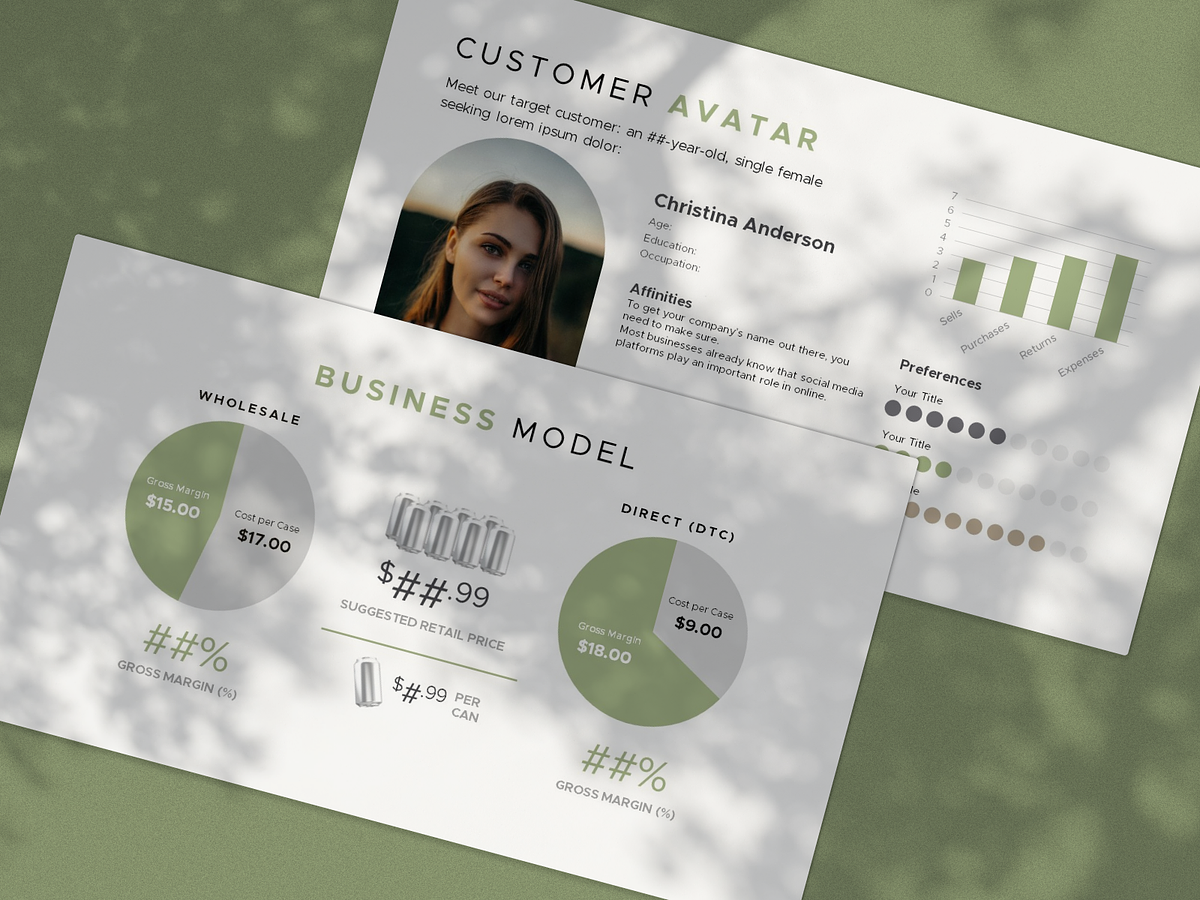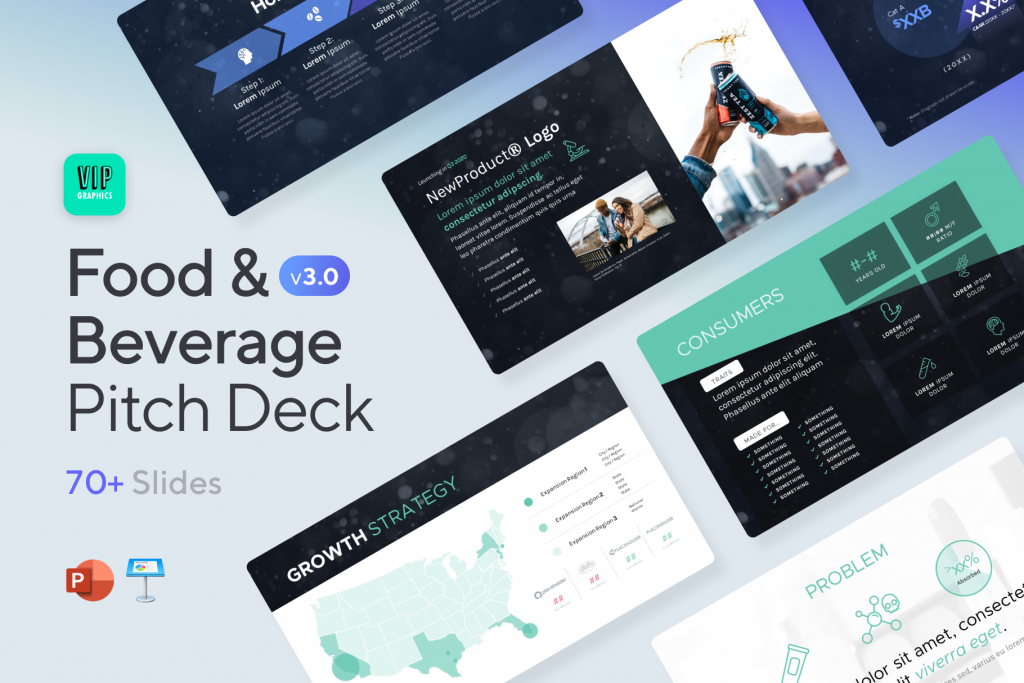The food and beverage industry is always evolving; today, F&B is undergoing a seismic shift, driven by changing consumer preferences (ie. ethically and sustainably sourced ingredients, plant-based meat alternatives, natural and organic foods, etc.). According to Statista, the global food industry is projected to reach a staggering $12.24 trillion by 2024. Yet, despite the immense potential of new F&B categories like plant-based foods, raising capital in this competitive landscape can be a daunting challenge for first-time founders in the space. This article will guide you through the art of creating an effective pitch deck tailored to the food and beverage sector, helping you communicate your vision and the market opportunity to potential investors.
Successful food and beverage pitch decks highlight the company’s values, ideal customers, competitive edge, and predicted profitability. Well-crafted pitch decks help impress investors and business partners.
What is a food & beverage pitch deck?
For a food & beverage company, pitch decks can serve multiple purposes: from raising funding from investors to winning distribution deals with retailers. Your pitch deck is a powerful medium for conveying the business idea, market potential, unique features, and the plans for achieving success.
An effective pitch deck should condense the essence of a business to pique the interest of potential investors, partners, or retail collaborators.
What is the purpose of a F&B pitch deck?
Whether your goal is to raise investor funding or secure distribution with a big-box retailer, your pitch deck will play a critical role in the success of your food or beverage brand.
An investor pitch deck aims to persuade potential backers to provide financial backing for the company’s operations. It’s essential to showcase the issue that the product solves, the market potential, the product’s USPs, the financial projections, and the team’s skills in an investor presentation.
On the other hand, a retail / distributor pitch deck is made with retailers in mind and highlights the benefits the product can offer to their shelves. These presentations typically focus more on the product’s marketability, sales tactics, distribution channels, promotional resources, and competitive edge.
While both investor and retail partner presentation decks contain similar information, they are organized differently to meet the specific expectations and requirements of their respective audiences.
What slides should be in your F&B pitch deck?
We’ve written previously about how to create a distributor deck for CPG brands, so we’ll focus on what to include in an F&B investor deck here. Learn how to develop a food and beverage pitch deck that will wow even the pickiest investors.
Cover Slide
Unveil your brand and vision in the cover slide of your pitch deck. This slide should include your company name, logo, and (most importantly) stunning imagery of your products. Many F&B pitch decks include a tagline or slogan that sums up the company value proposition. Don’t underestimate the importance of this slide: it should make an excellent first impression with eye-catching imagery and strong branding that leaves your audience wanting more.
Problem Slide
In the F&B industry, many businesses don’t necessarily seek to answer a problem, but rather fill a gap in the market or improve upon an existing offering. For example, Belgian Boys was founded to make Belgian sweets like stroopwafels, cookie tarts, and crêpes available to American consumers. In such cases, the “Problem” slide should focus on consumer wants / needs and the opportunity for innovation.
Solution Slide
The solution slide is your product’s chance to shine. Here’s where you show off your food or beverage innovation and explain how it’s the perfect solution to fill the void in the market. As a rule of thumb, show, don’t tell—whether you want to showcase a unique flavor combination or sustainable packaging, use images instead of words wherever possible. At the same, be sure to describe the benefits of your solution, such as a faster prep time, healthier ingredients, better pricing, etc.
Product Slide
While the solution slide speaks to your innovative approach, the Product slide is where you can show off your delicious creation. The focus of this slide should be eye-catching photos of your products. Include a short, enticing description emphasizing its best features: whether it’s a delicious taste, a healthier option, or a unique experience, talk about how your product fulfills the needs of your target market.
Competitive Advantage Slide
The competitive advantage slide is arguable the most important slide of every pitch deck. This page should outline differentiating features that will empower your F&B company to outpace the competition. Research your rivals in the industry and explain what makes your product or service better. Put the spotlight on what makes your company unique, and why consumers will prefer your products.
This is a great place to mention any awards or achievements bestowed upon your products, and cite evidence (such as customer feedback or statistics) to support that your F&B products are superior. This slide is where you get to assert your culinary authority and convince your audience that your business is the best-in-class.
Market / Opportunity Slide
The market slide of your pitch deck helps investors understand how big of an opportunity your company is targeting, and why now is the right time to invest. Don’t merely emphasize the overall size of the market: cite trends & tailwinds to demonstrate why now is the perfect time for your product(s).
One good approach to build a compelling case is to highlight the unfilled niches or demands in the market that your product fills, and consumer trends (ie. healthier options, sustainability, and one-of-a-kind culinary experiences) that support your success. Investors should walk away from the slide convinced that your business is uniquely positioned to capitalize upon a multi-million-dollar opportunity.
Target Market Slide
Your ideal customers should be the focus of the target market slide in your food and beverage (F&B) startup’s pitch deck. Your first step should be to identify your primary and secondary demographics with respect to age, gender, geography, etc. Once you have identified this, you can build a detailed customer persona with purchasing behavior, pain points, and preferences.
Explain how your product solves their problems and caters to their inclinations and habits. Using photos of example consumers is a great way to humanize your ideal customer persona. Display the results of any surveys or studies you conducted to confirm your understanding of the market.
Traction Slide
The Traction slide in your F&B pitch deck is where you can flaunt your business’s success and momentum. This slide is a testimonial to your efforts and proves your products will achieve product-market fit (PMF). Describe significant achievements, such as awards, distributor partnerships, or notable sales milestones.
Exhibit any noteworthy acclaim your startup has received, such as press or media coverage. If your product has been well received, you can prove it by providing consumer testimonials and social media comments.
Roadmap Slide
The roadmap slide should offer a picture of the journey you’ll take from where you are now to where you want to be. To get started, create a timeline that includes all of the major milestones you hope to accomplish. Make sure to consider product development, growth strategies, and partnerships, including details on any new products, expansion plans, or untapped markets. By displaying your strategic vision on this slide, you may reassure investors that your F&B startup is well-planned and will achieve sustainable & scalable growth.
Team Slide
The Team slide in your F&B pitch deck lets you showcase the brains behind the concept and show off the experience that will drive your business forward. Highlight essential team members by describing their positions, educational backgrounds, and prior work experience in the food and beverage sector. Give us a taste of their professional background, highlighting their accomplishments and past experience. Put a face to the names on your list to make it more relatable to your readers.
Highlight your team’s dedication to making your F&B stand out. This slide shows a cohesive force ready to fulfill your presentation’s promises to convince your audience that your culinary dreams are in capable hands.
Investment Slide
No investor deck is complete without an Investment Ask slide, where you list your fundraising needs and goals. Start by clearly articulating how much money you need to expand your business, then specify how the money will be spent to achieve your goals (ie. research and development, advertising, expanding current operations, or penetrating new markets).
The best investment slides include both a use of funds breakdown, as well as the associated milestones the funding will help achieve. If you’ve raised funding before, be sure to mention any notable investors.
Vision Slide
The Vision slide in your food and beverage pitch deck shows your company’s overall goal. Get your F&B creation moving in the right direction by declaring your mission and values. Write about the company’s long-term success, whether it’s a cultural phenomenon, social change catalyst, or taste revolution. Think forward to see how the product develops and grows to appeal to a wider range of consumers.
Call to Action Slide
Every deck should end with a call-to-action slide to inspire your audience to take the next step. Be specific about what you hope to accomplish, whether it’s getting funding, making connections, or setting up a follow-up meeting. Allow interested parties to contact you for further discussion. Open the floor for comments, questions, and curiosities to start the dialogue.
Tips for designing a winning food & beverage pitch deck
- Focus on market trends: Trends can help you rise above the competition; it’s not just about the size of the market. Emphasize the “why now” by explaining how your food and beverage business responds to your target market’s needs.
- Showcase metrics that matter: Quantifiable metrics are your friends, and substantiate your qualitative claims. Use data to back up your claims about demand and your product’s value proposition. Evidence from complex data, such as growth rates, sales, or customer reviews, strengthens your argument.
- Market and opportunity focus: Focus on the market and how big of a business you can build. Stay away from the boring details of “how it works” and focus on the thrilling possibilities your F&B startup offers. Clearly illustrate the need you’re answering and how your solution speaks to unfulfilled desires in the market.
Need help with your food & beverage pitch deck?
The Food & Beverage pitch deck is essential for those within the culinary industry aiming to secure investments and partnerships. If you’re intrigued, VIP.graphics has meticulously designed a remarkable Food & Beverage Pitch Deck Template. These thoughtfully crafted slides have a proven track record of closing deals for F&B startups. Crafting a compelling presentation that mirrors your culinary vision has never been more streamlined — check it out here.

